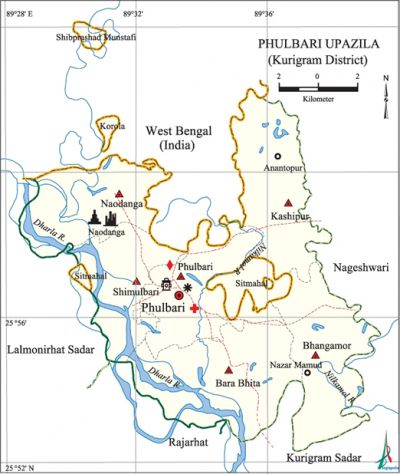Phulbari Upazila (Kurigram District)
Phulbari Upazila (kurigram district) area 156.61 sq km, located in between 25°32' and 26°04' north latitudes and in between 89°28' and 89°40' east longitudes. It is bounded by west bengal state of India on the north, kurigram sadar, rajarhat and lalmonirhat sadar upazilas on the south, nageshwari upazila on the east, Lalmonirhat Sadar upazila on the west. This upazila has 3 enclaves.
Population Total 160250; male 78568, female 81682; Muslim 143447, Hindu 16763, Christian 6 and others 34.
Water bodies Main rivers: dharla, Nilkamol.
Administration Phulbari Thana was formed in 1914 and it was turned into an upazila in 1983.
| Upazila | ||||||||
| Municipality | Union | Mouza | Village | Population | Density (per sq km) | Literacy rate (%) | ||
| Urban | Rural | Urban | Rural | |||||
| - | 6 | 48 | 166 | 12895 | 147355 | 1023 | 47.9 | 44.5 |
| Upazila Town | ||||||||
|
Area (sq km) |
Mouza |
Population |
Density (per sq km) |
Literacy rate (%) | ||||
| 8.74 | 1 | 12895 | 1475 | 47.9 | ||||
| Union | ||||
| Name of union and GO code | Area (acre) | Population | Literacy rate (%) | |
| Male | Female | |||
| Kashipur 54 | 6819 | 15445 | 15690 | 43.9 |
| Naodanga 67 | 6413 | 10940 | 11607 | 39.1 |
| Phulbari 40 | 5882 | 15603 | 16353 | 46.7 |
| Bara Bhita 13 | 8137 | 13788 | 14621 | 47.0 |
| Bhanagmore 27 | 6652 | 14487 | 14642 | 47.6 |
| Shimulbari 81 | 4798 | 8305 | 8769 | 41.4 |
Source Bangladesh Population Census 2011, Bangladesh Bureau of Statistics.

Archaeological heritage and relics Bishnu Mandir, abandoned Zamindar Bari and Mandir at Naodanga.
War of Liberation On 27 March 1971 an encounter was held between the freedom fighters and the Pak army. Freedom Fighter Lutfor Rahman, a member of the EPR was martyred in the encounter. Pak army tried to enter Phulbari on 20 April 1971 but they failed and in the face of resistance by the freedom fighters the enemies had to retreat that time. The freedom fighters also had encounters with Pak army at places of the upazila like Kulaghat, Kawahaga and Kalakhawa.
For details: see ফুলবাড়ী উপজেলা, বাংলাদেশ মুক্তিযুদ্ধ জ্ঞানকোষ (Encyclopedia of Bangladesh War of Liberation), বাংলাদেশ এশিয়াটিক সোসাইটি, ঢাকা ২০২০, খণ্ড ৫।
Religious institutions Mosque 261, temple 11.
Literacy rate and educational institutions Average literacy 44.8%; male 50.0%, female 39.8%. Noted educational institutions: Phulbari Degree College (1973), Naodanga School and College (1919), Phulbari Jasimia High School (1938), Kursa Fursa Government Primary School (1940), Shah Bazar AH Fazil Madrasa (1956), Naodanga DS Dakhil Madrasa (1969).
Cultural organisations Library 3, club 11, cinema hall 1.
Amusement centres Phulsagar, Zamindar Bari at Naodanga, Dharla Barrage.
Main sources of income Agriculture 74.28%, non-agricultural labourer 5.18%, industry 0.25%, commerce 9.31%, transport and communication 1.70%, service 3.81%, construction 0.65%, religious service 0.18%, rent and remittance 0.17% and others 4.47%.
Ownership of agricultural land Landowner 57.95%, landless 42.05%; agricultural landowner: urban 49.57% and rural 58.66%.'
Main crops Paddy, wheat, jute, potato, betel leaf, mustard, onion, garlic, vegetables.
Extinct or nearly extinct crops Dhemsi, china, aus paddy.
Main fruits Mango, jackfruit, litchi, papaya, blackberry, kamranga, betel nut, latkan.
Fisheries, dairies and poultries Hatchery 2.
Communication facilities Pucca road 100.34 km, mud road 412.74 km; waterway 2 km.
Extinct or nearly extinct traditional transport Palanquin, horse carriage, bullock cart.
Noted manufactories Biscuit factory, ice factory.
Cottage industries Goldsmith, jute work, embroidery, potteries, manufacture of decorated hand operated fan, bamboo work.
Hats, bazars and fairs Hats and bazars are 16, most noted of which are Balar Hat, Phulbari Hat, Kharibari Hat and Ganga Hat.
Main exports Paddy, jute, betel leaf, onion, betel nut, vegetables.
Access to electricity All the unions of the upazila are under rural electrification net-work. However 14.7% of the dwelling households have access to electricity.
Sources of drinking water Tube-well 98.5%, tap 0.1% and others 1.4%.
Sanitation 72.3% of dwelling households of the upazila use sanitary latrines and 21.0% of dwelling households use non-sanitary latrines; 6.7% of households do not have latrine facilities.
Health centres Upazila health complex 1, satellite clinic 3, clinic 1.
Natural disasters Many people were victims of the famine of 1974. Besides, the flood of 1988 caused heavy damages to settlements, crops and livestock of the upazila.
NGO activities Operationally important NGOs are RANGPUR DINAJPUR RURAL SERVICE, brac, Solidarity. [Mirza Md. Nasir Uddin]
References Bangladesh Population Census 2001 and 2011, Bangladesh Bureau of Statistics; Cultural survey report of Phulbari Upazila 2007.
